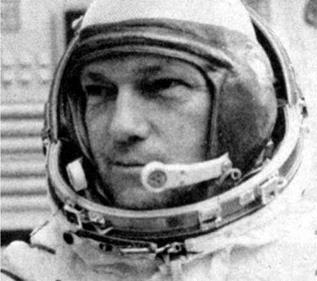MOON-LANDING TEAM
Meantime, crews were also formed for the landing mission, to fly the LOK and the LK. This included some from the L-1 group. These were also two-person crews, the commander taking the LK down to the surface, making the moonwalk and returning, while the flight engineer circled in lunar orbit. The L-1 experience in flying out to the moon and back was considered important in shaping these selections (a similar consideration was evident in American selections). For the landing mission, the first group of six was formed on 2nd September 1966:
First group of six: Yuri Gagarin, Viktor Gorbatko, Yevgeni Khrunov, Alexei Leonov, Andrian Nikolayev and Vladimir Shatalov.
Yuri Gagarin’s appointment as leader was not as obvious as it looked. Following his flight in April 1961, he had spent several years as a global ambassador for the Soviet Union, a task he had performed with great aplomb. Soviet space chiefs also took the view that he was too valuable to be risked for further space missions. This was a decision he took badly and over 1963-5 he became a more problematical personality and his behaviour declined. In late 1966, he was allowed to resume training and was told he would get an early Soyuz mission, though not the first one. Eventually, he managed to win the assignment of backup to the first Soyuz mission, which eventually flew in April 1967. He took these responsibilities with his old seriousness, his health improved radically and his famous smile reappeared. This assignment meant that he would certainly command the next Soyuz mission.
At this stage there seems to have been a further dispute between those like Kamanin who wanted the cosmonauts to have a hands-on role during their mission; and chief designer Mishin who followed Korolev’s view that there should be a high degree of automation. These arguments were not unknown in the American programme, though they were resolved at the earliest stage, in favour of the astronauts. By the end of 1967, no progress had been made in the provision of simulators, for they had been cancelled by Mishin. He may have considered them unimportant if most of the flight to and from the moon was under automatic control. Mishin also tried to increase the role of civilian engineers at the expense of the military. In August 1967, he now nominated a group of OKB-1 engineers for the landing mission:
OKB-1 engineer group for the landing mission: Sergei Anokhin, Gennadiy Dolgo – polov, Vladimir Nikitsky (replaced by Vladimir Bugrov), Viktor Patsayev, Valeri Yazdovsky.
The first moves to form a formal moon team for the N1-L3 missions took place in October 1967. The head of the cosmonaut team, General Kamanin, had a preference for veterans and that the LK pilot should have spacewalking experience. This narrowed the field, since only one had such experience, Alexei Leonov, but more would by the time of the mission. The first landing group was selected in December 1967:
Pilots: Alexei Leonov, Andrian Nikolayev, Valeri Bykovsky, Yevgeni Khrunov, Viktor Gorbatko, Boris Volynov, Georgi Shonin, Anatoli Kuklin, Anatoli Filip – chenko, Valeri Voloshin (replaced by Pytor Klimuk).
Engineers: Konstantin Feoktistov, Alexei Yeliseyev, Vladislav Volkov, Valeri Kubasov, Oleg Makarov, Vitally Sevastianov, Nikolai Rukhavishnikov, Valeri Yazdovsky, Georgi Grechko, Vladimir Bugrov.
Training began in January 1968. Some members of the group were already involved in the L-1 Zond programme. This was not seen as presenting a problem, since the landing missions were not then due until 1970-1. The same simulator problem also affected
|
|
|
The moon teams: Moon Team 1: Alexei Leonov, Oleg Makarov |
![]()

|

this group. These cosmonauts did very little training because of the lack of availability of simulators.
Eventually, a 20-person lunar landing group was agreed on 13th March 1968:
Commanders: Valeri Bykovsky, Anatoli Filipchenko, Viktor Gorbatko, Yevgeni Khrunov, Anatoli Kuklin, Alexei Leonov, Andrian Nikolayev, Georgi Shonin, Valeri Voloshin, Boris Volynov.
Engineers: Konstantin Feoktistov, Georgi Grechko, Valeri Kubasov, Oleg Makarov, Vladimir Bugrov, Vitally Sevastianov, Nikolai Rukhavishnikov, Vladislav Volkov, Valeri Yazdovsky, Alexei Yeliseyev. Also assigned: Valentin Yershov.
The cosmonaut team – indeed the whole space programme – suffered a major blow in March 1968 when its leading personality died in a plane crash. Yuri Gagarin had been devastated by the death of Soyuz commander and friend Vladimir Komarov the previous year. Yuri Gagarin had been backup to Komarov and would automatically have been slated to fly the next Soyuz mission, although that had not been decided at that time. After the crash of Komarov he was grounded again, but by the end of 1967, still pressing for a flight, he had been given permission to fly again under strict conditions. On 29th March, experienced instructor Vladimir Seregin and cosmonaut Yuri Gagarin took off on a routine training flight. It seems that their MiG-15 encountered wake turbulence from the jet flow behind an unannounced MiG-21 in the area at the same time, putting their own plane into a spin. They plunged direct into the forest, killing both men outright. His funeral was the biggest there ever was in Moscow. The loss of the young, ever-popular and globally admired Gagarin was a body blow the programme could ill afford.
On 18th June 1968, the final group for the moon landing was selected:
Final group: Valeri Bykovsky, Alexei Leonov, Anatoli Voronov, Yevgeni Khrunov, Alexei Yeliseyev, Oleg Makarov, Nikolai Rukhavishnikov, Viktor Patsayev.
This was the ‘landing group’ for at least the following year and formed the basis of the assignment for the first two landing crews (the third is more speculative).












